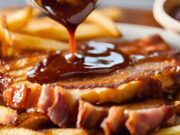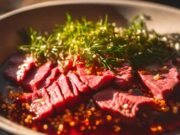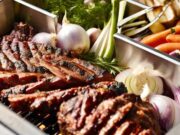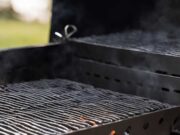Barbecuing is a cherished activity, but it presents certain safety challenges, particularly concerning cross-contamination.
Ensuring that your food remains safe to eat is essential for a successful cookout. This article examines what cross-contamination entails, how to prevent it starting from the moment you shop for ingredients, and the critical techniques for proper handwashing and cleaning.
It will also address safe cooking practices and effective management of leftovers, allowing you to enjoy your BBQ with confidence and peace of mind.
Key Takeaways:
- Keep raw and cooked food separate when shopping, storing, and cooking to prevent cross-contamination.
- Proper handwashing and cleaning of surfaces and equipment are essential in avoiding the spread of harmful bacteria.
- Cook meat to safe temperatures and avoid undercooking to prevent foodborne illnesses. Properly handle and store leftovers to avoid contamination.
How to Avoid Cross-Contamination at Your BBQ: Essential Practices
Cross-contamination at your BBQ can lead to serious foodborne illnesses, making it essential to implement practices that ensure food safety. This involves understanding the risks associated with raw meat and cooked food, as well as maintaining proper kitchen hygiene and cleanliness.
By adhering to safety guidelines, utilizing effective food handling techniques, and ensuring that your employees are well-trained, you can create a safe and enjoyable BBQ experience for your guests. Additionally, employing restaurant tips and effective cleaning procedures can significantly reduce the risk of food contamination.
A proactive approach to food safety will not only protect your health but also enhance your BBQ gatherings.
Understanding Cross-Contamination
Cross-contamination refers to the transfer of harmful bacteria, allergens, and other pathogens from one food item to another, particularly between raw and cooked foods. This poses serious risks to food safety.

This process can occur in various settings, from home kitchens to commercial food preparation areas. It often happens through shared utensils, cutting boards, or even hands that have come into contact with contaminated items.
For instance, if raw chicken is cut on a knife that is later used for slicing vegetables without proper sanitation, dangerous bacteria like Salmonella could easily be transferred, leading to foodborne illnesses. Allergens such as peanuts or shellfish can also cause severe reactions if they come into contact with allergen-free foods, underscoring the critical importance of proper food handling practices.
Understanding these dynamics is essential for ensuring the safety and integrity of meals consumed.
Preventing Cross-Contamination: Key Practices
Preventing cross-contamination requires implementing a series of essential practices that ensure safe food handling and maintain a sanitary kitchen environment. These measures are vital in safeguarding against foodborne illnesses.
Shopping and Storing BBQ Ingredients
When shopping for BBQ ingredients, it is essential to prioritize food safety by selecting fresh produce, ensuring raw meat is properly packaged, and avoiding cross-contamination with allergens.
One effective strategy is to examine the packaging of products carefully; look for any signs of damage or tampering, as these may indicate potential contamination. It is advisable to keep raw meat separate from fruits and vegetables in your shopping cart to eliminate the risk of cross-contamination.
Once you have selected your ingredients, take them home promptly and store the meat at the bottom of the refrigerator, ideally at temperatures below 40°F to inhibit bacterial growth.
For longer storage, consider freezing the meat and storing dry goods like spices in a cool, dry place to maintain their freshness. This approach ensures that your BBQ gathering not only tastes great but is safe for all to enjoy.
Essential Handwashing and Cleaning Techniques
Essential handwashing and cleaning techniques are critical for maintaining kitchen hygiene and preventing cross-contamination during BBQs.
Plus thorough handwashing, it is important for you to understand the proper methods for cleaning and sanitizing various surfaces in the kitchen. This includes using hot, soapy water to scrub counters, cutting boards, and any utensils that may come into contact with food.
Equally important is the use of approved sanitizing solutions on food contact surfaces to eliminate harmful bacteria. After cleaning, ensure that these surfaces are thoroughly dried to prevent further contamination.
By integrating effective sanitation practices, you not only safeguard your culinary creations but also promote overall health and well-being during social gatherings.
Cooking and Serving Safely
Cooking and serving food safely is essential for preventing cross-contamination. It is important to ensure that all ingredients are prepared at safe cooking temperatures to minimize the risk of foodborne illness.
Cooking Meat to Safe Temperatures
Cooking meat to safe temperatures is essential for maintaining food safety, and utilizing a food thermometer can help you ensure that raw meat is cooked thoroughly to prevent illness.
Different types of meat require specific internal temperatures for safety. For example, poultry should reach an internal temperature of 165°F, while ground meats like beef and pork should attain at least 160°F to effectively eliminate harmful bacteria. Whole cuts of beef, lamb, and pork should be cooked to a minimum of 145°F, followed by a resting time of three minutes for additional safety.
It is crucial to remember that visual cues, such as color and juices, can be misleading. Therefore, relying on a food thermometer is the most reliable method for confirming doneness and ensuring that harmful pathogens are eradicated, ultimately safeguarding health and preventing foodborne illnesses.
Avoiding Under-cooking and Serving Practices
Avoiding under-cooking and adhering to proper serving practices are essential in minimizing the presence of foodborne pathogens in cooked food.
When meals are not cooked to the appropriate temperatures, harmful bacteria such as Salmonella and E. coli can survive, posing significant health risks to diners. These pathogens can lead to serious foodborne illnesses, often resulting in symptoms like nausea, vomiting, and diarrhea.
To ensure safety, it is important to utilize a food thermometer to check internal temperatures and comply with guidelines established by health organizations. Implementing proper hygiene practices, such as regular handwashing and preventing cross-contamination, further enhances the safety of prepared meals.
By making conscientious choices in food preparation, you not only protect your own health but also contribute to safeguarding public well-being.
Managing Leftovers
Managing leftovers properly is essential to preventing foodborne illness and ensuring food safety in any BBQ setting.
After the grill has cooled down and the event has concluded, it is important to evaluate how to store those remaining delicious dishes effectively. Your priority should be to refrigerate or freeze leftovers within two hours of cooking to preserve freshness and minimize bacterial growth.
Utilizing airtight containers or resealable bags will help maintain quality and keep flavors intact. It is also crucial to label each container with the date to track how long the food has been stored.
When it comes time to reheat, ensure that leftovers are heated to an internal temperature of at least 165°F to eliminate potential pathogens. Additionally, maintaining a clean kitchen is vital in preventing cross-contamination, ensuring that your culinary experience remains both safe and enjoyable.
Frequently Asked Questions
What is cross-contamination and how can it happen at a BBQ?
Cross-contamination occurs when harmful bacteria from one food item spreads to another food item. This can happen at a BBQ when raw meats come into contact with cooked foods or when utensils and surfaces used for raw meats are not properly cleaned before being used again.
What are some essential practices to prevent cross-contamination at a BBQ?
Firstly, always use separate cutting boards, utensils, and plates for raw meats and cooked foods. Make sure to thoroughly wash and sanitize these items before reusing them. Additionally, keep raw meats stored in sealed containers or separate cooler bags to avoid any juices from dripping onto other foods.
Are there any specific temperature guidelines to follow when grilling to prevent cross-contamination?
Yes, it is important to use a food thermometer to ensure that all meats are cooked to their appropriate internal temperature. This not only ensures the safety of the food, but it also helps to kill any harmful bacteria. Ground beef should be cooked to 160°F, poultry to 165°F, and pork and beef steaks to 145°F.
Can cross-contamination occur with fruits and vegetables as well?
Yes, cross-contamination can happen with any type of food. It is important to wash all fruits and vegetables thoroughly before cutting or consuming, and to use separate cutting boards and utensils for these items as well.
What should I do if I suspect cross-contamination has occurred at my BBQ?
If you notice that raw meats have come into contact with other foods, it is best to discard those items and start fresh. It is better to be safe than sorry when it comes to food safety.
Any additional tips for avoiding cross-contamination at a BBQ?
Yes, make sure to wash your hands frequently with soap and water, especially after handling raw meats. Also, try to keep raw meats in a separate cooler or on the bottom shelf of the fridge to prevent any juices from dripping onto other foods. And finally, always use a clean plate for cooked meats instead of placing them back on the plate that held the raw meats.



















































